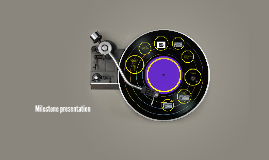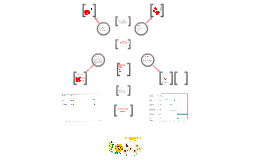Milestone Presentation
Transcript: P06 Azure Milestone Current Prototype Design Instructions 1. Cut Poly Tubing to desired length 2. Leave poly tubing out in the sun to dry to rid of the curves and bends. 3. Soak the ends of the poly tubing in hot water to ensure a secure fit to the male and female couplings 4. Fix up the main line using the GI Reducer Tee and 25mm Poly Pipes. 5. Attach lateral line to the reducer tee and punch holes in the lateral lines 20cm apart to place the emitter. (Mistakes from hole punching can be rectified with a goof plug) 6. Hold the main and lateral line in place using pin holders stucl to the ground 7. Place end caps at the ends of the lateral lines as well as the main lines. 8. "Hose out" entire system before utilising it. 9. Use plumbers tape to secure each connection between the pipes and the end caps. Irrigation Design Irrigation 1m 1m Application Rate (cm/hr) Flow rate of each emitter = 2L/hr Number of emitters per line = 5 Flower rate per lateral line = 2L/h x 5 = 10L/h Number of lateral lines = 3 Outflow rate of system assuming 100% efficiency = 3 x 10L/h = 30L/h 1m Flow Rate Calculations Inflow Rate > Outflow Rate Assuming outflow rate needed = 30L/h Inflow rate >30L/h To maintain a positive pressure on the system for the emitters to work. Inflow rate(L/h) = Storage size(L) / Fill Time(s) x 3600 x 0.8 (account for pressure loss) - Coagulation is achieved by adding cationic proteins to stable greywater colloids and hence increase density of the opposing ionic layers surrounding the greywater particles. - The reduction of electrostatic repulsion forces allow the particles to floc together are thus absorbed by the moringa seed proteins. (Hendrawati, H. et al., 2016) Moringa Seeds Greywater Chemistry (Saini, R. K., Sivanesan, I., & Keum, Y.-S., 2016) Lime More H+ (hydronium) ions present from lime juice (weak acid), increases acidity, decreases pH of overall greywater mix when added: (Citric acid pH ~ 4.9-5.3) (ChemistryLibretexts, 2013) Graph 1. demonstrating linear relationship between -ve logs of OH- and H3O+ ions (ChemistryLibretexts, 2013) Figure 1. Process of greywater intermolecular charge neutralisation (Çeçen, F., Aktaş, Ö., Çeçen, F., & Aktaş, O. z. r., 2012) External and intraparticle transport of absorbate in G.A.C. Granular Activated Carbon - Adsorption is the capacity of a solid particle to attract molecules to its surface. - Absorbate can be dyes or organic chemicals that diffuses through the liquid film - Intraparticle diffusion occurs where the adsorbate transfers from the surface of a particle such as the activated carbon to sites within the particle --> adsorption occurs - Hence, physical properties of activated carbon can have a significant impact on the decolorization rate of azo dyes when mixed over time. (Çeçen, F., Aktaş, Ö., Çeçen, F., & Aktaş, O. z. r., 2012) In terms of filtration, the amphipathic (attracts polar and non-polar) attraction capacity combined with the chemical and physical stability of SiO2 and SiO4 results in a wide range of contaminants being susceptible to filtration from the initial medium without compromising the SiO2 and SiO4 molecules and lattices respectively (This strength is due to the covalent bonds; especially SiO2) (Petrucci et al., 2007) Sand/Gravel Boba Babies is attempting to determine a viable grey-water treatment system and to do so, will compare various technologies to establish the most efficient technologies that can be used in conjunction with one another to create a water treatment system. Six different water filtration systems are being considered as a result of the literature review completed to determine effective technologies that can remove grey-water contaminants. Overview Decision-Making Matrix N.B. The set-up for all options will be the same of using a down-filter of stacked reducer joints (excluding option 3 which uses a ceramic pot, and for this the water will first be processed through the pot and then collected to go through the reducer joints). Double click to edit TREATMENT SYSTEMS for comparison OPTIONS Double click to edit PAIRWISE COMPARISON PAIRWISE COMPARISON option rankings OPTION RANKINGS From the options rankings, Option 4 had the highest weighted score of 3.8108 and therefore most suitable as a system. To ensure this choice is made properly, a sensitivity analysis will be completed. This component is considering the "what if?" of events that could occur in the external environment that can change the importance of certain criteria and therefore which systems are better to use. Two key changes were considered: the Dili waste management expanding to the Manufahi district and if education and training facilities were implemented by EWB to aid the Timorese. Sensitivity Analysis SENSITIVITY ANALYSIS Though the values did fluctuate with the changes in the external environment, Option 4 remained the highest scoring option and therefore the system that will be used. Mass balance Agriculture reuse and waste disposal Agricultural -

















